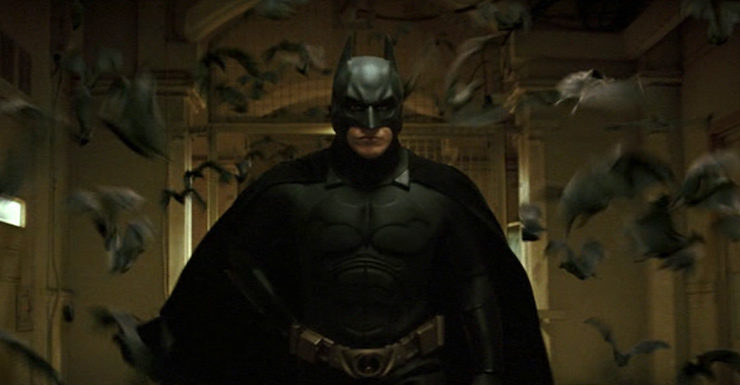After the soul-destroying horrendousness of Batman & Robin in 1997, Warner Bros. kept trying to figure out ways to restart the Batman film franchise, which went from the hottest thing since sliced bread in 1989 to the poster-child for awful superhero movies eight years later. The planned fifth film in the 1990s series, Batman Unchained, to be directed again by Joel Schumacher, was scrapped when B&R failed like a big giant failing thing, and Warner decided to start over.
They finally did it with Christopher Nolan, fresh off his success with Memento.
Warner’s notion pretty much from the minute they decided to abandon moving forward with Unchained was to do an adaptation of Frank Miller & David Mazzucchelli’s groundbreaking “Batman: Year One” story arc in issues #404-407 of Batman from 1987. Schumacher had expressed interest in doing that film, and in addition at one point Miller and Darren Aronofsky were attached to an adaptation of the comic. Warner later hired both the Wachowskis and Joss Whedon to write scripts for a “Year One” film, but neither wowed the execs. (I would’ve loved to have seen Aronofsky or the Wachowskis take this one. Whedon not so much—while I’d love to see his take on Superman, I can’t see him getting Batman.) M. Night Shyamalan was also at one point attached to direct.
Buy the Book
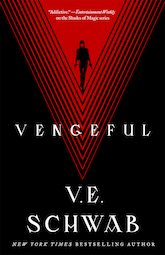

Vengeful
Finally, after a few other projects stalled, they hired Nolan and David S. Goyer in 2003. Nolan’s self-professed “jumping-off” point was a comics story by Denny O’Neil & Dick Giordano that appeared in the Secret Origins trade paperback in 1989. Using various bits of Bat-backstory over the decades, O’Neill wrote a story that told of Bruce Wayne’s adventures learning everything he could in the years between the death of his parents and his adoption of the cape and cowl. (Kind of what we’re seeing done in Gotham, only, y’know, not bonkers.) In addition, Goyer based his story not just on “Year One,” but also on the Jeph Loeb/Tim Sale miniseries The Long Halloween, which was a sequel to “Year One” that dug into the Falcone crime family.
Christian Bale had been champing at the bit to play Batman ever since he read a copy of Grant Morrison & Dave McKean’s Arkham Asylum graphic novel. He was connected to Aronofsky’s version of the film, and he nailed his audition with Nolan. Others who were considered included Henry Cavill (who would later go on to take over Superman in the current DC Extended Universe), Cillian Murphy (whose audition was strong enough for Nolan to offer him the consolation prize of playing Scarecrow), Heath Ledger (who would wind up being one of the villains in the next film in the series), Billy Crudup (later to play Dr. Manhattan in Watchmen), David Boreanaz (who had already made a name for himself as the dark and brooding Angel in Buffy the Vampire Slayer and Angel), Josh Hartnett (who would go on to star in Sin City), and more.
Nolan generally wanted an A-list cast, as he felt it would lend more gravitas to the proceedings (a philosophy also followed by Kevin Feige at Marvel Studios), hence the hiring not only of Bale, but also Michael Caine, Morgan Freeman, Rutger Hauer, Katie Holmes, Liam Neeson, Gary Oldman, Ken Watanabe, and Tom Wilkinson. This was Caine’s first film with Nolan, but far from the last, as he’s been in pretty much every Nolan film since. In addition, Nolan would work with both Bale (The Prestige) and Watanabe (Inception) after this.
“Bats frighten me—it’s time my enemies shared my dread”
Batman Begins
Written by David S. Goyer & Christopher Nolan
Directed by Christopher Nolan
Produced by Charles Roven and Emma Thomas and Larry Franco
Original release date: June 15, 2005
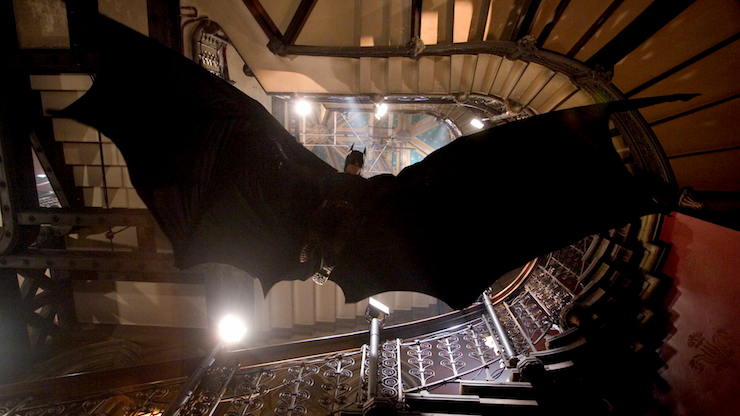
Young Bruce Wayne is playing in the yard of the mansion his parents own, along with Rachel Dawes, the daughter of the maid. They find an old arrowhead on the ground, then Bruce falls into an unseen hole in the ground and is badly hurt and also frightened by the many bats that fly out at him.
Adult Bruce wakes up from a nightmare of remembering that fall. He’s in a prison in Bhutan, where he’s made a habit of beating up the other inmates. He’s freed by a man who calls himself Ducard and says he works for Ra’s al-Ghul. Ra’s is the head of the League of Shadows, a covert organization that tries to maintain order and justice. Ducard trains Bruce in various martial arts (judo, ninjitsu, and kendo, at the very least) and also in how to be aware of his surroundings.
At one point, Bruce tells Ducard why he is training himself: he wants to be a force for justice after his parents were killed. When Bruce was a boy, he and his parents came into Gotham on the monorail that Thomas Wayne built for the city with his considerable monies, and saw the opera. But Bruce finds himself reminded of the bats, and asks to leave early. On the way home, they’re mugged, Bruce’s parents killed. Bruce is comforted by Officer James Gordon, and then is told by Detective Loeb that they got the guy who did it, Joe Chill.
Years later, Bruce comes home after being kicked out of Princeton in order to attend a hearing for Chill, who is promised early release in exchange for testimony against crime boss Carmine Falcone. As soon as the judge lets him go, he’s shot outside the courthouse—to Bruce’s disappointment, as he’d gotten a gun into the courthouse, er, somehow and was intending to shoot Chill himself.
Rachel, who is now an assistant district attorney, drives him down to where Falcone hangs out—along with several of the judges, politicians, and cops on his payroll, among them the judge who let Chill go. It’s likely that the hearing was a way to get Chill out in public so he could be shot and killed to protect Falcone. Rachel leaves Bruce there, to see the reality of life in Gotham for people who aren’t billionaires. Bruce confronts Falcone, but Falcone is unimpressed and has Bruce beaten up and left out on the street.
Jumping ahead to the present, Ducard has a penultimate test for Bruce, which he passes by fooling Ducard into thinking he’s somewhere he isn’t. But the final test is to kill a murderer—and that’s a line that Bruce won’t cross. Instead, he tries to escape; he sets a fire that causes the gunpowder Ra’s keeps to explode. Ra’s is accidentally killed by a falling ceiling beam after a prolonged fight with Bruce. Bruce pulls Ducard from the fire and then travels home.
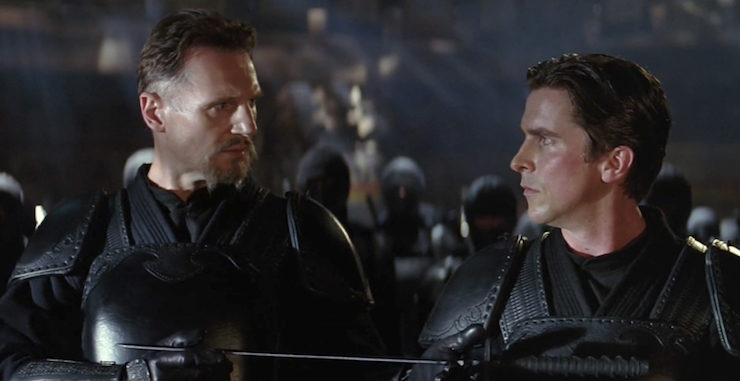
The Wayne family butler, Alfred, who raised Bruce, is still living at the mansion, and welcomes Bruce home. Bruce has been missing for more than seven years and he’s been declared dead, so there’s that to untangle. He goes to Wayne Enterprises to find that CEO William Earle is going to take the company public. Bruce asks for a job to get to know the company he’ll inherit better, and Earle sends him to Lucius Fox in development—which is pretty much a black hole in the company where old projects go to die. Fox is a bit of a gadfly, and he questioned Earle once too often. Many of his projects are things they developed for the military that were either impractical or too expensive (or both), including a Kevlar bodysuit, a tank, and a smart cloth that can reshape itself into something rigid. Bruce takes one of each…
At Alfred’s suggestion, Bruce cultivates an idle rich goofy-ass playboy persona for public consumption, while he puts bat-insignia on the bodysuit and fashions graphite helmets with bat-ears so he can be the thing that he fears: a bat.
As Batman, he torments Falcone’s people, assembling evidence for Rachel, with help from now-Sergeant Gordon. He actually manages to tie Falcone directly to drug-smuggling.
However, Falcone has an arrangement with Dr. Jonathan Crane. Many of Falcone’s thugs have been declared insane by Crane after arrest, and sentenced to Arkham Asylum, and then released fairly soon by one of the judges in Falcone’s pocket. When he’s arrested, Falcone himself gets the same treatment—but Crane is concerned that Falcone might talk about him and their mutual big boss, so he uses a hallucinogenic on Falcone that makes him see his greatest fears.
Falcone’s drug shipments have been split in two. Half go to street dealers, but no one seems to know where the other half goes, not even Gordon’s incredibly corrupt partner Flass. When Batman tracks down Crane, Crane hits him with the hallucinogenic. Batman is barely rescued by Alfred, and he’s out for two days before Fox can synthesize an antidote. Meanwhile the DA discovers that Falcone’s impounded evidence includes one more crate than on the manifest—it turns out to contain a microwave gun from Wayne Enterprises that can vaporize a water supply. The DA is shot after discovering this.
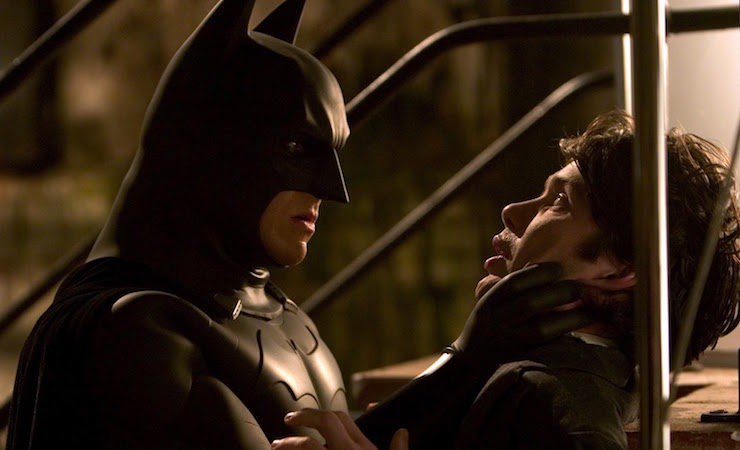
Rachel comes by the Wayne mansion to give Bruce a birthday present: the arrowhead they found as kids. She then says she has to look into Falcone deeper, as her boss has been missing for two days.
When Rachel arrives at Arkham, she declares that she wants her own shrink to look at Falcone, not Crane, and Crane can’t let that happen, so he gasses Rachel right after he shows her that they’ve been putting his hallucinogenic in the water supply.
Batman is able to rescue Rachel and also interrogate Crane after giving him a taste of his own medicine. He says he’s working for Ra’s al-Ghul, but Batman doesn’t believe that, because he saw Ra’s die. He takes Rachel to the Batmobile and escapes after a lengthy pursuit from the cops.
Earle learns that the microwave gun has gone missing. He asks Fox about the weapon’s capabilities, and then when Fox starts asking questions, Earle fires him.
Bruce is holding a birthday party at his mansion, and Fox is there as well. After bringing Rachel to the Batcave and curing her, Bruce heads up to the party urges Fox to synthesize more of the antidote.
A woman introduces Bruce to Ra’s al-Ghul—a different person from the one Bruce met in Bhutan. Then Ducard steps forward—turns out, he was Ra’s all along. He feels that Gotham is beyond saving, and he plans to use Crane’s hallucinogenic to make all the citizens of Gotham sick with fear, and the city will tear itself apart.
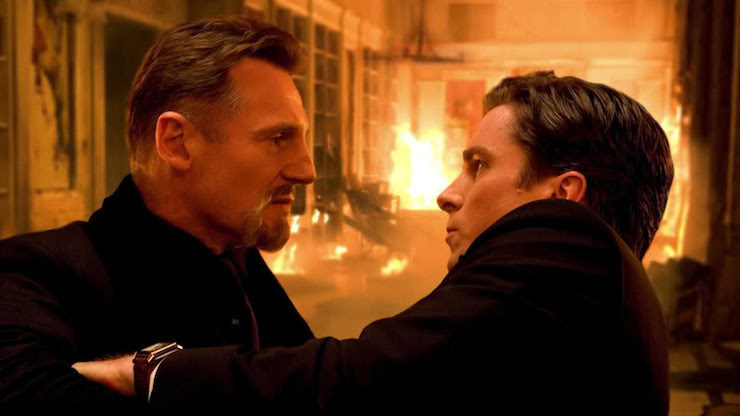
Bruce pretends to throw a tantrum in order to get his party guests to leave, but Ra’s doesn’t care about them. He burns the mansion down, and leaves Bruce for dead, though he’s saved by Alfred.
Suiting up in the Batcave, he meets up with Gordon. Ra’s has freed the inmates from Arkham, and the GCPD has their hands full with the escapees. Ra’s is riding with the monorail to Wayne Tower to activate the microwave gun, which will vaporize Gotham’s water supply, thus making Crane’s hallucinogenic airborne. Batman gives Gordon the keys to the Batmobile instructing him to blow up the monorail before the train can get there. Meantime, Batman confronts Ra’s on the train. Lengthy fisticuffs ensue, and too late Ra’s realizes that the fight was just a distraction so he wouldn’t notice that Gordon blew up the tracks. Batman escapes and Ra’s plummets to his doom.
With Falcone arrested, Crane discredited (though still at large), and the League of Shadows broken, things are better in Gotham. Rachel has figured out that Bruce is Batman, and kisses him in the wreckage of the Wayne mansion before saying she can’t be with him because of his dual life. Many of the various charities and small corporations that bought shares in Wayne Enterprises’ public offering were actually owned by Bruce, so he’s now majority stockholder, and he fires Earle and replaces him with Fox. Gordon is promoted to lieutenant and has set up the bat-signal. He also tells Batman about some guy who’s been robbing banks and leaving Joker cards behind…
“Why do we fall?”
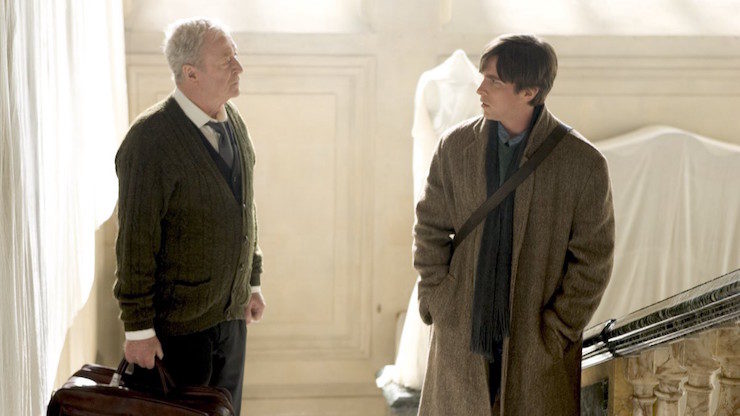
A great movie about Batman’s early days, with flashbacks to his origin, a love that can’t happen, lots of gangsters, and one of Batman’s iconic comics villains—I am, of course, talking about the 1993 animated film Mask of the Phantasm. A spinoff of the brilliant 1990s Batman: The Animated Series produced by Bruce Timm—which remains the best adaptation of Batman ever—Mask covers a lot of the same territory as Begins. Screenwriter Goyer insisted that he was more influenced by The Long Halloween than he was the “Year One” storyline, but I find it impossible to credit that he wasn’t at least a little bit influenced by the 1993 animated feature, too (which also took cues from “Year One”).
The thing is, almost everything that you see in both movies, Phantasm does better. Better Batman, better headlining bad guy, better love interest, better gangsters, better action sequences, better pre-costume attempt to be a vigilante, better surprise reveal of one of the bad guys. (Plus, there’s no scene in Begins that’s as devastatingly, eerily, scarily effective as Batman’s interrogation of Councilman Reeves in the hospital in Phantasm.)
Not to say that Begins is a bad film, but it’s nowhere near as good as its outsized reputation. Said rep is probably at least in part due to its competition which, as we’ve seen in this rewatch, was abysmal. 2005 was quite possibly the nadir of 21st-century comic book adaptations, with such gems as Elektra, Constantine, Son of the Mask, Man-Thing, The Crow: Wicked Prayer, and Fantastic Four. Plus this is the guy who did Memento! And it’s got Morgan Freeman and Michael Caine and Christian Bale and Liam Neeson and stuff!
There are elements that work. I like the idea that a lot of Batman’s best training came from one of his greatest enemies. Ra’s al-Ghul has always been a particularly compelling enemy of Batman’s, and Neeson actually plays him well—while he’s inferior to David Warner’s voice on the animated series, he’s better than either Alexander Siddig on Gotham (who’s actually good in the role) or Matt Nable on Arrow (who really wasn’t). I like Gary Oldman’s Gordon, who is very much like the Gordon of “Year One” (whatever Miller’s flaws as a writer, he always wrote Gordon well, as he’s the best character in both “Year One” and The Dark Knight Returns). I especially like how he doesn’t participate in the corruption but won’t rat on his fellows, either. But he has an innate goodness and desire to help people—you can see it etched in his pores, and you have no trouble believing that Batman focuses on it when he recruits Gordon.
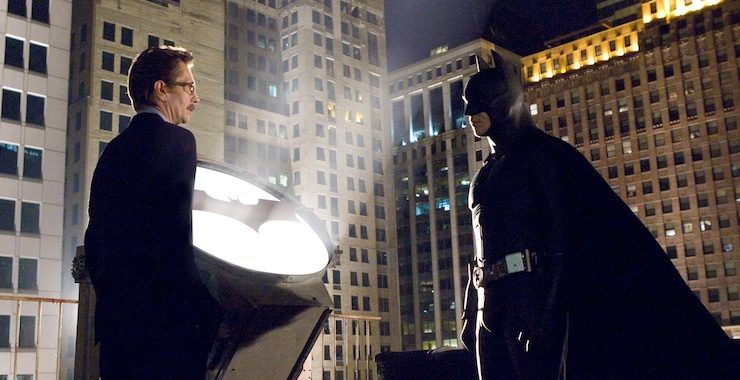
I’m very fond of the notion that part of Batman’s training was in learning how criminals think. It’s borne of his conversation with Falcone, where the gangster points out to the entitled rich kid that he’ll never understand the behavior of a desperate person like Chill who’s driven to theft and murder. So he goes out to do so, and by the time Ra’s/Ducard finds him, he refuses to kill—he’s seen the desperation that Falcone said he couldn’t understand, and he won’t set himself up as executioner. I’m glad that Nolan understands this fundamentally important aspect of Batman’s character, and I also like that he went on a journey to get there, from taking a gun to kill Chill himself to eventually realizing that he can’t be the one to take a life the way Chill took away his parents’.
Having said that, Nolan tries to eat his cake and have it too, since he is creating a summer blockbuster, and our bloodthirsty society still insists that the bad guy must die in the end. So Batman lets Ra’s die on the train rather than try to save him, which is the opposite of how Batman would behave. Admittedly, this is the guy who burned his house down and was about to kill an entire city, not to mention his hinting that he may have been responsible for murdering his parents. That, at least, is left sufficiently vague—it could’ve been simply Ra’s trying to get a rise out of Bruce—but I’m really tired of all the attempts to add artificial meaning to Batman’s origin, whether it’s Jack Napier having been the one to do it in 1989’s Batman or the Court of Owls conspiracy in Gotham. What made it so devastating was that it was just a random act of violence, endemic of Gotham City’s problems. Making the Waynes a deliberate target defeats the purpose and cuts off Bruce’s own grief and narrative at the knees.
Also, you’ll notice that I’ve been saying “parents” a lot, though you’d be forgiven if, after watching this movie, you’d be surprised to learn that Bruce Wayne had a mother. Played by Sara Stewart, they may as well have just hired a blonde extra, because she has no dialogue, no character, no personality, no relevance to the storyline. None of Bruce’s memories are of her, and nobody ever even mentions her, it’s always “your father” this and “your father” that. Zack Snyder has come in for lots of flack for trying to make Golden Age writers’ inability to come up with more than one name for their flagship heroes’ Moms into a plot point, but at least Batman v. Superman acknowledged Martha Wayne’s existence.
The performances in this movie are generally good, though I found myself least impressed with the title character. Surprisingly for someone as famously method as Bale, I found his performance to be a little too surface-y without much by way of depth. Since the entire movie was about Bruce’s journey, it left me a bit flat. (Again, Kevin Conroy did way better with just his voice in Phantasm.) Michael Caine, at least, keeps the streak of superlative Alfreds in live action going—like Alan Napier and Michael Gough before him and Sean Pertwee and Jeremy Irons after him, Caine is rock-solid in the role of Batman’s lone support.
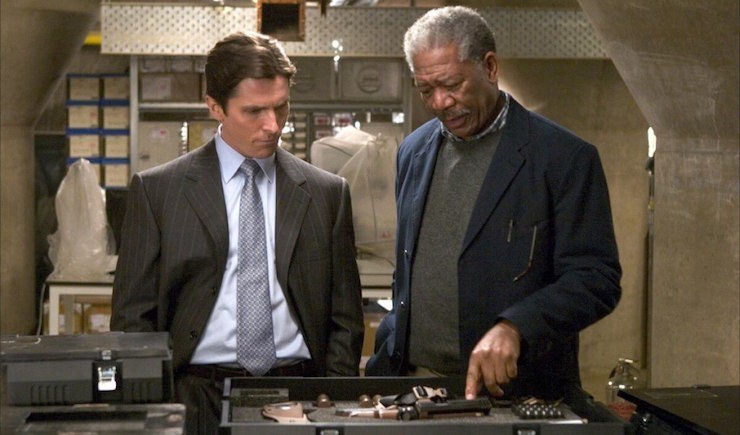
Though he isn’t actually Batman’s lone support, as he also has Fox and Dawes, neither of whom quite land. In the 1989 film, Joker famously asked, “Where does he get those wonderful toys?” and actually answering that question mostly leads to eye-rolling, as poor Morgan Freeman is stuck in the role of Magical Negro Q, providing Batman with Chekhov’s Armory, equipment that happens to be perfect for crime-fighting while dressed as a bat but wasn’t mass-produced for various plot-convenient reasons.
As for Dawes, the filmmakers allegedly wanted to have Harvey Dent in that role, but they found it wasn’t working, so they changed it to his childhood friend-turned-prosecutor, and I call bullshit. Except for the kiss at the end, you can swap out Dent for Dawes easily without changing a single line of dialogue or a single plot point, and you’d have bonus foreshadowing for the next movie to boot! (Having said that, Dent is one of the best elements of that next movie—but we’ll talk about that in a week…) I’m firmly convinced that the nonsense about not being able to do justice to Dent’s character was just that: nonsense. Just as the bad guy must die in the end to satisfy Hollywood blockbuster clichés, your macho male lead must have a love interest to fulfill other Hollywood blockbuster clichés, never mind that (the current storyline in the comics with Batman and Catwoman getting married notwithstanding) Batman and romance has never been a strong fit. You’d think Nolan would have learned from the sodden attempts at romance in the two Tim Burton films. (I hasten to add that none of this is Katie Holmes’s fault. She also came in for flack after this film as its weak point, but that’s a script problem, not an acting problem. She did just fine.)
You’d also think that Nolan would have not taken his fight-scene cues from the incomprehensible jump-cutting of the Burton and Schumacher films, but he does the same thing, making it pretty much impossible to follow what the hell’s going on during the action scenes. This is especially bad during the film’s endless climax, as we’re treated to the low comedy of Gordon driving the Batmobile, while the train Batman and Ra’s fight on seems to be on an asymptotic curve, getting closer and closer to Wayne Tower, but never arriving (it’s like Lancelot’s run toward the castle in Monty Python and the Holy Grail, which isn’t a touchstone you want in your super-serious, realistic superhero movie).
Also, they don’t call it the Batmobile, because in a movie that’s about a rich guy who dresses up as a giant bat, in a movie in which the plot involves poisoning the water supply with fear gas and using a big ray gun to evaporate all the water to make it airborne, they thought using the word “Batmobile” would be silly. Right.
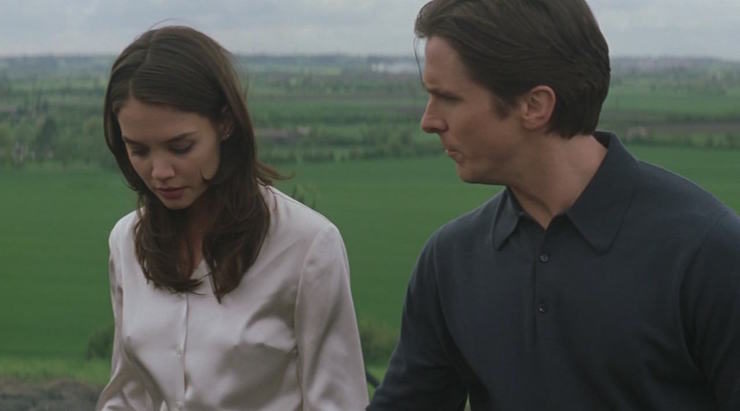
The secondary bad guys are hit-and-miss. Cillian Murphy is brilliant as Crane—he honestly deserved to be the primary villain of a film rather than Ra’s’s flunky—but Tom Wilkinson is incredibly bland as Falcone. Phantasm had much better bad guys. Hart Bochner was as good as Murphy in his role as Reeves; all three actors who played gangsters in the animated film—Abe Vigoda, Dick Miller, and John P. Ryan—were light-years better than Wilkinson; and as good as Neeson is, he can’t hold a candle to Mark Hamill’s Joker, still the best comic book villain ever realized on screen (and yes, that includes the guy we’ll be talking about next week). Dana Delaney’s Andrea Beaumont is a much better love interest than Holmes’s Dawes, and the reveal that she’s really the Phantasm is way more effective than the revelation that Ducard is Ra’s. (Here’s a hint, guys—if you don’t want us to guess that Liam Neeson is playing an iconic comics character, don’t give him the same facial hair as said iconic comics character. Back in ’05 I guessed he was Ra’s right away.)
Begins is a good movie, but it falls very far short of being as good as it could be. Declared the best Bat-movie ever made at the time of its release, it isn’t even the best Bat-movie with this plot.
However, it was a massive success. Nolan had envisioned a trilogy, with the beginning, middle, and end of Batman’s career, and next week we’ll take a look at that middle, with our rewatch of The Dark Knight.
Keith R.A. DeCandido is pleased that all five books in his Precinct series of fantasy police procedurals are now available from eSpec Books: Dragon Precinct, Unicorn Precinct, Goblin Precinct, Gryphon Precinct, and Tales from Dragon Precinct. Ordering links can be found here. He’s hard at work on Mermaid Precinct, and hopes to have it out this fall.










